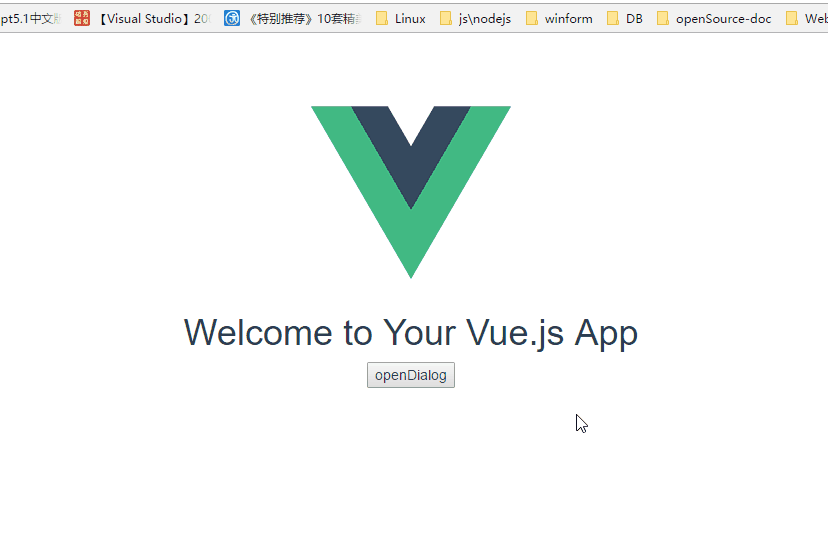多层弹出时,只有一个背景层。
弹出层嵌入内部组件。
弹出层按钮支持回调
源码下载
实现

多层弹出时,只有一个背景层
利用两个组件实现,一个背景层组件(只提供一个背景层,组件名:background.vue),一个弹出层内容管理组件(实现多个内容层的管理,组件名:master.vue)。
弹出层嵌入内部组件
使用vue的component组件实现,他可以完美支持。
弹出层按钮支持回调
在master.vue中实现,详细解析此代码
html代码
<template> <div> <div v-for="(comp,index) in comps" v-bind:style="style(index,comp)" > <div > header </div> <div> <component :is="comp"></component> </div> <div> <button type="button" v-on:click="clickHandler(btn.value, comp, index)" v-for="btn in btns" >{{btn.text}}</button> </div> </div> <hDialogBack ref="back" v-bind:z-index="realIndex-1" ></hDialogBack> </div> </template>
comps:内部组件的集合
realIndex:一个computed属性,读取props的mIndex属性,表示内部层的zIndex层级关系。
component加载组件
btns:表示按钮的集合,现还不支持组件独立配置按钮列表。
style:此方法用于生成内部组件居中的css代码。
js代码:
<script> import hDialogBack from './background' function getclientPoint () { return { width: document.documentElement.clientWidth || document.body.clientWidth, height: document.documentElement.clientHeight || document.body.clientHeight } } export default { name: 'HDialog', data () { return { comps: [] } }, props: { 'btns': { type: Array, default: function () { return [{ text: 'ok', value: 'ok'}, { text: 'cancel', value: 'cancel'}] } }, 'mIndex': { type: Number, default: 19861016 } }, computed: { realIndex: function () { return this.mIndex } }, components: { hDialogBack }, methods: { open: function (comp) { comp.promise = new Promise(function (resolve, reject) { comp.resolve = resolve comp.reject = reject }) comp.width = comp.width || 600 comp.height = comp.height || 400 this.comps.push(comp) if (!this.$refs.back.show) { this.$refs.back.open() } return comp.promise }, clickHandler: function (type, comp, index) { let self = this let close = function () { self.comps.splice(index, 1) if (self.comps.length === 0 && self.$refs.back.show) { self.$refs.back.close() } } /** 只提供promise模式 */ comp.resolve({'type': type, 'close': close}) }, style: function (index, comp) { let point = getclientPoint() return { zIndex: this.realIndex + index, width: comp.width + 'px', height: comp.height + 'px', left: ((point.width - comp.width) / 2) + 'px', top: ((point.height - comp.height) / 2) + 'px' } } } } </script>
open方法,用于打开弹出层,且返回一个Promise。
嵌入background.vue组件,用于提供背景层。
clickHandler方法:master.vue组件按钮的事件响应函数,会resolve在open方法中提供的promise。
css代码:
<style> .modal-content { position: absolute; } </style>
如何实用
首先需要在顶层引入master.vue,然后嵌入到与app组件平级,如下代码:
new Vue({ el: '#app', template: '<div><App></App><HDialog ref="hDialog" ></HDialog></div>', components: { App } })
一定要指定ref值,这是弹出层实现的关键。
在任意一个子组件中如下使用:
let promise = this.$root.$refs.hDialog.open({ template: '<div>第二层了</div>' }) promise.then(function (arg) { alert('第二层' + arg.type) arg.close() })
使用$root.$refs找到弹出层管理组件
使用调用其open方法,并接受一个promise类型的返回值
使用promise即可。
发布到npm
如果组件需要被其他人引用,最好使用commonjs2规范,webapck如下配置:
output: { path: './dist', filename: '[name].js', library: 'vue-hdialog', libraryTarget: 'commonjs2' }
在npmjs上注册一个账号
利用npm login 登录
使用npm publish 发布,如果你想卸载可以用npm unpublish --force.
发布是需要package.json检测version和name字段,如果已存,或者是存在被卸载的都不行。
package.json中的main节点是指定其他引用时,默认导出的文件。
本文已被整理到了《Vue.js前端组件学习教程》,欢迎大家学习阅读。
关于vue.js组件的教程,请大家点击专题vue.js组件学习教程进行学习。
